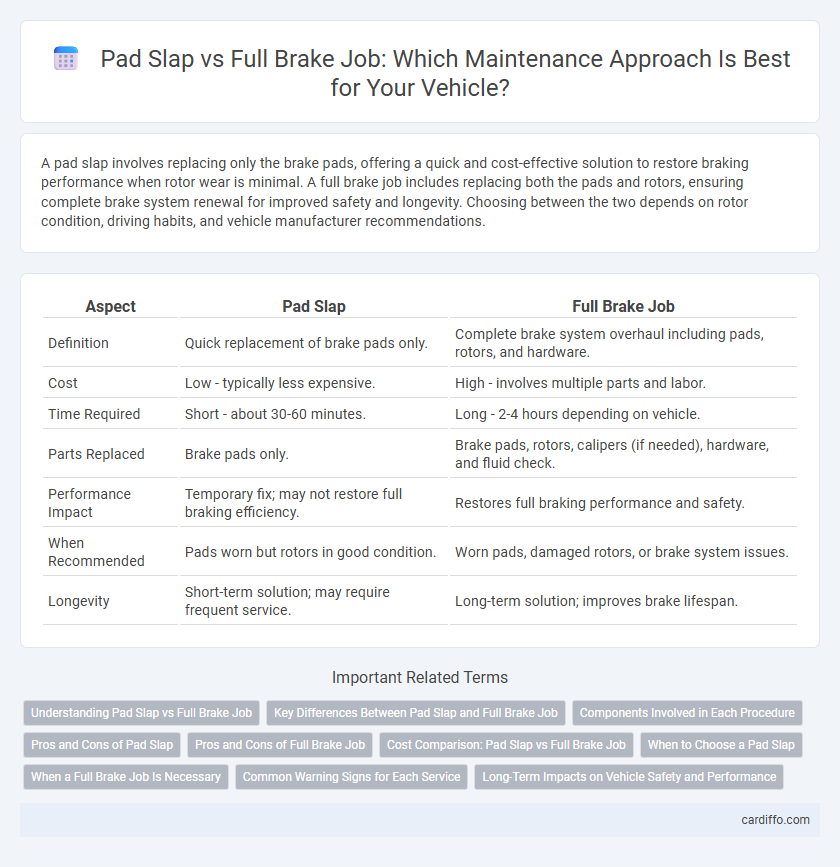A pad slap involves replacing only the brake pads, offering a quick and cost-effective solution to restore braking performance when rotor wear is minimal. A full brake job includes replacing both the pads and rotors, ensuring complete brake system renewal for improved safety and longevity. Choosing between the two depends on rotor condition, driving habits, and vehicle manufacturer recommendations.
Table of Comparison
| Aspect | Pad Slap | Full Brake Job |
|---|---|---|
| Definition | Quick replacement of brake pads only. | Complete brake system overhaul including pads, rotors, and hardware. |
| Cost | Low - typically less expensive. | High - involves multiple parts and labor. |
| Time Required | Short - about 30-60 minutes. | Long - 2-4 hours depending on vehicle. |
| Parts Replaced | Brake pads only. | Brake pads, rotors, calipers (if needed), hardware, and fluid check. |
| Performance Impact | Temporary fix; may not restore full braking efficiency. | Restores full braking performance and safety. |
| When Recommended | Pads worn but rotors in good condition. | Worn pads, damaged rotors, or brake system issues. |
| Longevity | Short-term solution; may require frequent service. | Long-term solution; improves brake lifespan. |
Understanding Pad Slap vs Full Brake Job
Pad slap is a quick, temporary fix that involves replacing only the brake pads to reduce noise and vibration, ideal for minimal wear scenarios. A full brake job includes replacing pads, rotors, and sometimes calipers, providing a comprehensive solution for extensive brake system wear or damage. Understanding the extent of brake wear and symptoms like squealing or reduced braking efficiency helps determine whether a pad slap or full brake job is necessary.
Key Differences Between Pad Slap and Full Brake Job
Pad slap involves replacing only the brake pads, which is a quicker and more cost-effective maintenance option primarily addressing pad wear. A full brake job includes replacing brake pads, rotors, and sometimes calipers, providing comprehensive restoration of braking components for improved performance and safety. Choosing between the two depends on the extent of brake wear, with pad slap suitable for minor issues and a full brake job necessary for severe rotor damage or brake system failure.
Components Involved in Each Procedure
Pad slap involves replacing only the brake pads, focusing on components such as the brake pads, caliper hardware, and sometimes the caliper slide pins. A full brake job includes pad replacement plus resurfacing or replacing rotors, checking brake fluid, inspecting calipers, brake lines, and wheel bearings for a comprehensive renewal. Each procedure targets different levels of wear and component health to ensure optimal braking performance.
Pros and Cons of Pad Slap
Pad slap offers a quick and cost-effective solution by replacing only the brake pads, reducing labor time and immediate expenses, which is ideal for minor wear and routine maintenance. However, this approach may overlook underlying issues like rotor wear or warping, potentially leading to reduced braking performance and shorter component lifespan compared to a full brake job. While pad slap minimizes downtime, it risks higher long-term costs due to less comprehensive system evaluation and repair.
Pros and Cons of Full Brake Job
A full brake job offers comprehensive maintenance by replacing all critical components including pads, rotors, calipers, and sometimes brake lines, ensuring optimal braking performance and safety. The main advantage is long-term reliability and thorough restoration of the braking system, reducing the likelihood of recurring issues and uneven wear. However, the primary downside is the higher initial cost and increased labor time compared to a simple pad slap, which may not be necessary if other components remain in good condition.
Cost Comparison: Pad Slap vs Full Brake Job
Pad slap offers a cost-effective solution by replacing only the brake pads, typically costing between $100 and $150, while a full brake job includes rotor resurfacing or replacement and can range from $300 to $800 depending on the vehicle make and model. Opting for a pad slap minimizes immediate expenses but may lead to higher costs if rotor damage worsens over time, requiring more extensive repairs. Evaluating brake system condition and long-term maintenance needs ensures the most economical choice between these two service options.
When to Choose a Pad Slap
Choose a pad slap when brake pads show moderate wear but rotors remain in good condition without deep grooves or warping. Performing a pad slap is cost-effective and efficient for maintaining braking performance during routine maintenance. Reserve a full brake job for severe rotor damage or when both pads and rotors require replacement to ensure safety and reliability.
When a Full Brake Job Is Necessary
A full brake job becomes necessary when brake pads are excessively worn, rotors are warped or deeply scored, and brake fluid is contaminated or leaking. Signs include persistent brake noise, reduced stopping power, and vibration during braking, indicating rotor replacement alongside pad replacement is required for optimal safety. Regular inspection by a certified mechanic ensures that components like calipers and brake lines are functioning properly to prevent more extensive damage.
Common Warning Signs for Each Service
Worn brake pads cause squealing or grinding noises, reduced braking efficiency, and a pulsating brake pedal, signaling the need for a pad slap. A full brake job becomes necessary when there are deep grooves on rotors, brake fluid leaks, or the vehicle pulls to one side during braking, indicating extensive wear or damage. Identifying these warning signs early helps maintain optimal braking performance and ensures safety.
Long-Term Impacts on Vehicle Safety and Performance
Pad slap, a temporary brake pad replacement, offers immediate cost savings but may compromise long-term vehicle safety by prematurely wearing rotors and causing uneven brake performance. A full brake job, including rotor resurfacing or replacement along with pads, ensures consistent braking efficiency and extends the lifespan of braking components, enhancing overall vehicle reliability. Choosing a comprehensive brake service reduces the risk of brake failure and maintains optimal performance under varying driving conditions.
Pad Slap vs Full Brake Job Infographic

 cardiffo.com
cardiffo.com